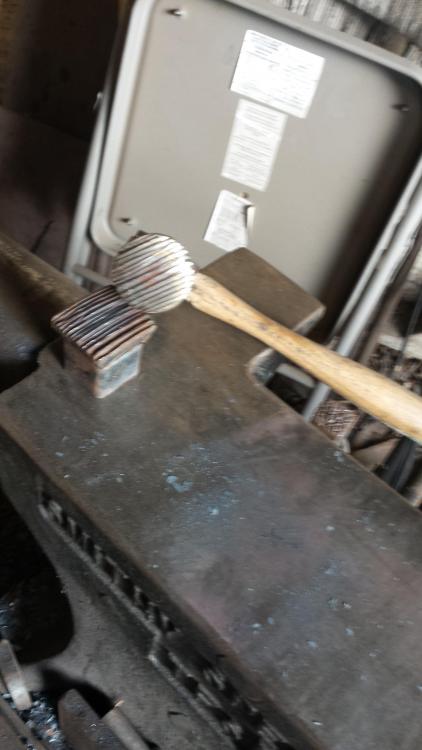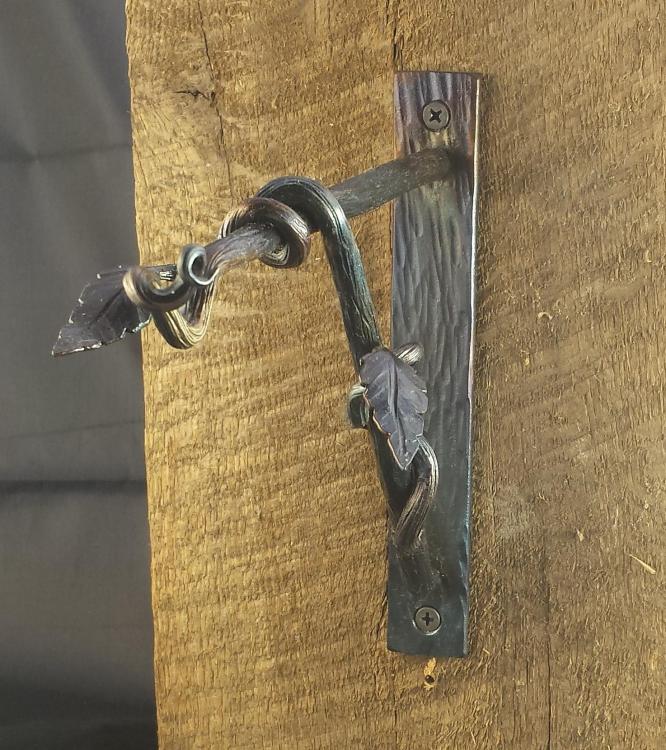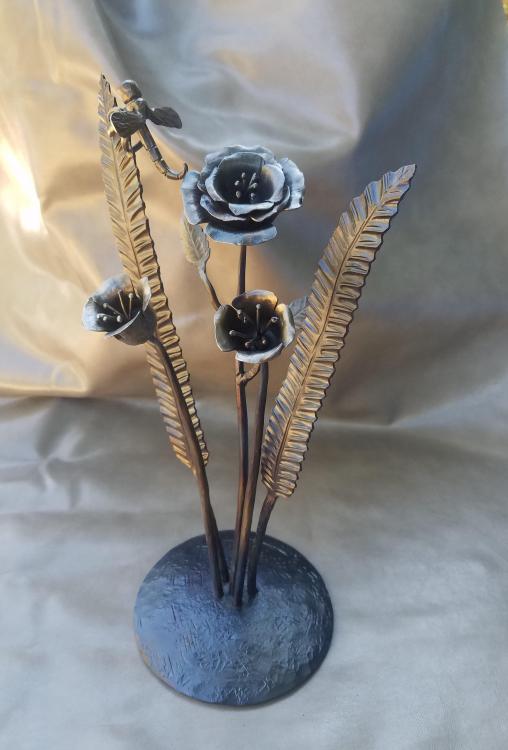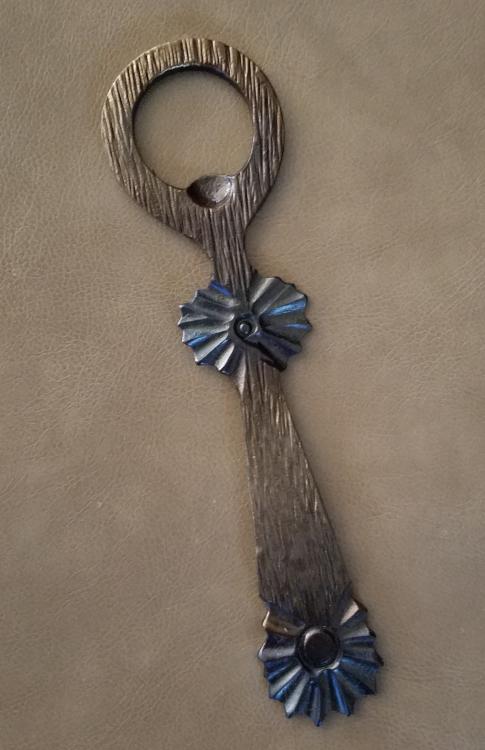
beammeupscotty
-
Posts
337 -
Joined
-
Last visited
Content Type
Profiles
Forums
Articles
Gallery
Downloads
Events
Posts posted by beammeupscotty
-
-
I don't know about a petrified wood texture, but to get a "viney"-"barky" texture, the two methods shown here already will certainly do the latter job. I opted to not use the spring fuller approach and instead modified a hammer as has been suggested. You also need to make a matching bottom swage. This is what I use:
Note that the lines cut into the face of the hammer are at a 45 degree angle compared to the axis of the hammer. This is to allow you to make parallel texture grooves while holding the hammer out of line with the stock. I like hammer application because you can more easily introduce some randomness to the texture, making it more natural looking than if you use a spring swage.
Video of discussion of and use of the pictured hammer/bottom tool. Texture application starts at about 18:54. Hope this helps.
-
On a London pattern anvil I would be very suspicious at the lack of a step. I would not be surprised if someone machined it off. That said, I understand your hesitance to dress the edges but you should really consider doing it. I felt the same way when I bought a new TFS anvil but I went ahead and did a conservative job of rounding the edges, then I ended up doing it 4 more times until I finally put large enough radii on it for the edges to be really useful. The comments suggesting that you do indeed lose energy by working on the bick seem accurate to me, but under normal conditions you would only use the bick when you wanted to very gradually draw something out so the loss of energy should not be a problem. If however, you are using the bick in lieu of the edges because your edges are too sharp, then you are just slowing yourself down. Dress the edges.
-
-
I have read that D2 rod is a good material for corkscrews.
-
I do much the same thing with standard red brick to make my coal or coke fire deeper. The fire pot in my antique forge really isn't quite deep enough.
-
I appreciate that politics has no real place here on IFI, but this was posted on the blacksmith subreddit and I feel it is important enough to warrent reposting here.
Please do not patronize Diamondback Ironworks.
Link removed due to conflict with IFI standards of posting, look it up yourself to see if you desire, warning language and racial slander.
-
If I were doing this project I think I would either used tenons into counter sunk holes in the back plate or plug welded the handles on to the back plate. That way, no welds would show.
-
The make great gongs.
-
-
Contrary to what Smoggy says, it is entirely possible that there are no suitable rocks in Iceland for making whet stones. This is because Iceland is essentially volcanic and traditional whet stones are either sedimentary or metamorphic. Iceland has not been around long enough to have either type of stone. Novaculite which is what traditional American sharpening stones are made of, (both Washita and Hard Akansas) fall in to this category. From Wikipedia:
" Novaculite is considered to be highly siliceous sediments and may be a product of the low-grade metamorphism of chert beds."
I am pretty confident that Japanese water stones are also sedimentary. Again, from Wikipedia"
"The geology of Japan provided a type of stone which consists of fine silicate particles in a clay matrix, somewhat softer than Novaculite. [10]
Japanese stones are also sedimentary."
It is possible to make a sharpening stone from just about any piece of rock, but it is not possible to make a GOOD sharpening stone from any old piece of rock. I think you are better off just buying them.
-
Great production value but unfortunately it does not appear that this old smith actually knows anything about blacksmithing.
-
-
I'm very happy to see some articulate push back on this post. Personally, I discounted it immediately simply based upon it's idiotic premise. Other's research into the OP has revealed that his "years" of hammering metal are in reality less than 1 year. After that revelation, everything else he states becomes nonsense, but absolutely in line with the what I would expect in an era where facts no longer matter.
-
I just use inexpensive ones purchased from Amazon: 4-1/2" Auto Body Sanding Flap Discs 80 Grit
Even if the expensive ones last twice as long, they cost close to 4 times as much. It is cheaper in terms of hours of grinding per dollar, to buy this type of flap wheel.
-
Tongs can be a pain to make, no doubt about it. There are however, easier ways and more difficult ways to make them. As has already been mentioned, twist tongs have an inherent weakness and I don't make them any more. The ones I do still have are rarely used and I built up that weak area with weld using a MIG so they are at least partially useful. The method I currently use I got from a youtube video by Rowan Taylor. Forge welding the reins on limits the amount of drawing out you have to do. This method yields very strong tongs with none of the weakness that twist tongs exhibit.
I would also recommend that you take a flap wheel to your off side edge, assuming that is where you draw out. You should polish up the bick as well. My experience has been that with any fuller, whether one that fits in the hardy hole, or your anvil edge or the bick or a top fuller, the smoother the surface is, the easier it moves metal.
-
7 hours ago, Ranchmanben said:
Yep, it's another rebar thread. I've done quite a bit of reading through the forum and found that large rebar has to meet higher standards than regular rebar and that it can be quite good for top tools, bottom tools and possibly even hammers. My question is what is considered large rebar? Is 1" large rebar? I've got a selection in my scrap pile ranging for 1" to 2". I assume the 1.5"-2" is large but I don't know how small still fits in that categorie. Thanks
What does "higher standards" mean and in what way do those "standards" make large diameter re-bar more suitable for tooling? I doubt you know the answer to this question and I suspect whoever you got this "information" from does not know it either. Beware "common knowledge". In my experience it is often a synonym for nonsense.
-
20 hours ago, zion2634 said:
Is the any blacksmith class's or schools that does night or weekends in northern California? Or is the anybody this area that would be willing to give me lessons?
I don't know if you are the same person who posted a similar question on Reddit yesterday, but if you are not, I am in the S. F. Bay Area and occasionally teach classes. When I do it is only on weekends. I am located in Concord.
-
These are my first two efforts a making videos as well as posting to youtube. The first is how I make one style of bottle opener and the second is a decorative leaf hook. Both videos are, I think, quite detailed and will hopefully be informative for serious beginners. The bottle opener video was originally intended to add a bit of information to the process shown in a video by someone who contributes on the blacksmith subreddit. Then it sort of got out of hand. There is a link to his video in the description section.
-
It that a Canarywood handle?
-
If I were going to make such an item, I would make it from something like 3/4" material so I could get something like a legitimate eye, then forge down the ends to the requisite 3/8" section.
-
Very nicely done!
-
Is that forged from a RR spike? The base looks like it might be.
-
On 3/25/2017 at 1:20 AM, Joel OF said:
As a self taught person and relative newbie (forged first taper in May 2013) I've come to the conclusion that anyone with patience and the knowledge of a few principles of how metal moves can be a blacksmith. You can scale the principles up or down and tackle things you've never done before with confidence that it'll work. We haven't got to worry about esoteric complications like wood grain and knots.
The vast majority of work I do I've never done before, I've certainly never done any riveting like this before. Where there's a will, there's a way.The skills are part of it but there is more to it than that. There is also vision and you also have that, in spades. I could never even visualize a piece of work like this, much less make it.
-
Excellent repurposing!




Working with Briwax?
in Finishes for Metal
Posted
That is how wax works. You cannot get any significant build up. It is still providing a very thin film of protection. Wax is soft however, so it is not a particularly durable finish.